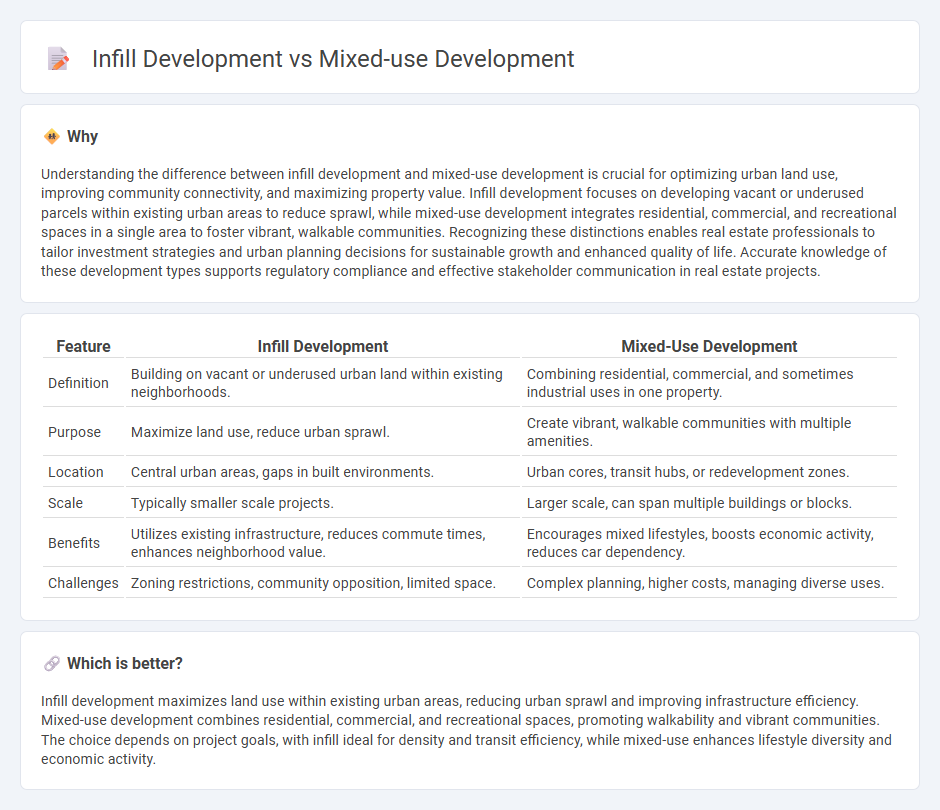
Infill development focuses on optimizing underutilized urban land parcels by introducing residential or commercial structures that complement existing neighborhoods, enhancing density without expanding city boundaries. Mixed-use development integrates residential, commercial, and sometimes industrial spaces within a single project to create vibrant, walkable communities that boost local economies and reduce reliance on cars. Explore the specific benefits and challenges of each approach to understand their impact on urban growth and sustainability.
Why it is important
Understanding the difference between infill development and mixed-use development is crucial for optimizing urban land use, improving community connectivity, and maximizing property value. Infill development focuses on developing vacant or underused parcels within existing urban areas to reduce sprawl, while mixed-use development integrates residential, commercial, and recreational spaces in a single area to foster vibrant, walkable communities. Recognizing these distinctions enables real estate professionals to tailor investment strategies and urban planning decisions for sustainable growth and enhanced quality of life. Accurate knowledge of these development types supports regulatory compliance and effective stakeholder communication in real estate projects.
Comparison Table
| Feature | Infill Development | Mixed-Use Development |
|---|---|---|
| Definition | Building on vacant or underused urban land within existing neighborhoods. | Combining residential, commercial, and sometimes industrial uses in one property. |
| Purpose | Maximize land use, reduce urban sprawl. | Create vibrant, walkable communities with multiple amenities. |
| Location | Central urban areas, gaps in built environments. | Urban cores, transit hubs, or redevelopment zones. |
| Scale | Typically smaller scale projects. | Larger scale, can span multiple buildings or blocks. |
| Benefits | Utilizes existing infrastructure, reduces commute times, enhances neighborhood value. | Encourages mixed lifestyles, boosts economic activity, reduces car dependency. |
| Challenges | Zoning restrictions, community opposition, limited space. | Complex planning, higher costs, managing diverse uses. |
Which is better?
Infill development maximizes land use within existing urban areas, reducing urban sprawl and improving infrastructure efficiency. Mixed-use development combines residential, commercial, and recreational spaces, promoting walkability and vibrant communities. The choice depends on project goals, with infill ideal for density and transit efficiency, while mixed-use enhances lifestyle diversity and economic activity.
Connection
Infill development and mixed-use development are connected through their shared goal of maximizing land use efficiency in urban areas. Infill development revitalizes underutilized parcels within existing neighborhoods, often incorporating mixed-use elements like residential, commercial, and public spaces to create vibrant, walkable communities. This integration enhances urban density, reduces urban sprawl, and promotes sustainable growth by leveraging existing infrastructure.
Key Terms
**Mixed-Use Development:**
Mixed-use development integrates residential, commercial, and recreational spaces within a single project, optimizing land use and fostering vibrant, walkable communities. This approach enhances urban density, supports local economies, and reduces the need for extensive transportation infrastructure. Explore how mixed-use development is transforming modern urban landscapes and boosting sustainable growth.
Zoning
Mixed-use development integrates residential, commercial, and recreational spaces within a single zoning district, promoting diverse land use and vibrant communities. Infill development concentrates on utilizing underused or vacant parcels within existing urban areas, often adapting zoning regulations to enhance density and connectivity. Explore more about how zoning influences the planning and execution of these sustainable urban development strategies.
Live-Work-Play
Mixed-use development integrates residential, commercial, and recreational spaces within a single community to promote a Live-Work-Play lifestyle, enhancing convenience and reducing commute times. Infill development revitalizes underutilized urban land by introducing new structures that complement existing surroundings, often supporting mixed-use projects with efficient land use and sustainable growth. Discover how these urban design strategies transform cities by balancing functionality and lifestyle.
Source and External Links
Supporting Active Living Through Mixed-Use Developments - Mixed-use development places multiple uses, like residential, commercial, and civic spaces, in close proximity, enabling people to live near everyday destinations and increasing opportunities for physical activity and community engagement.
Benefits of Mixed-Use Development in Urban Areas - Mixed-use developments combine residential, commercial, and sometimes industrial functions in a single area, optimizing land use, fostering vibrant communities, and supporting sustainable urban growth by integrating living, working, and recreation within walkable environments.
Mixed-use development - Mixed-use development blends residential, commercial, cultural, institutional, or entertainment uses into physically and functionally integrated spaces, which can apply to single buildings, neighborhoods, or city-wide zoning policies to enhance urban life and connectivity.
 dowidth.com
dowidth.com